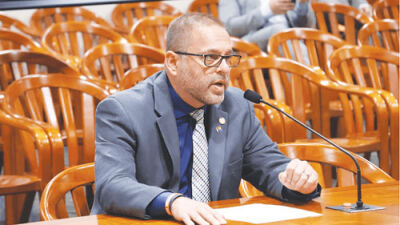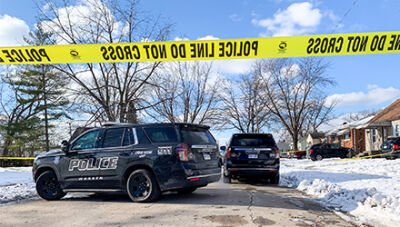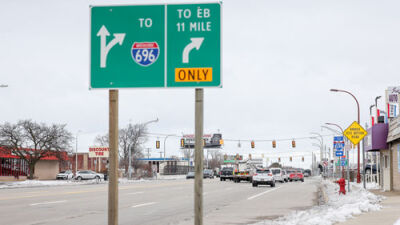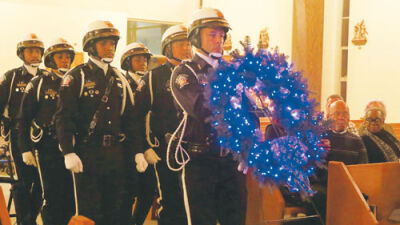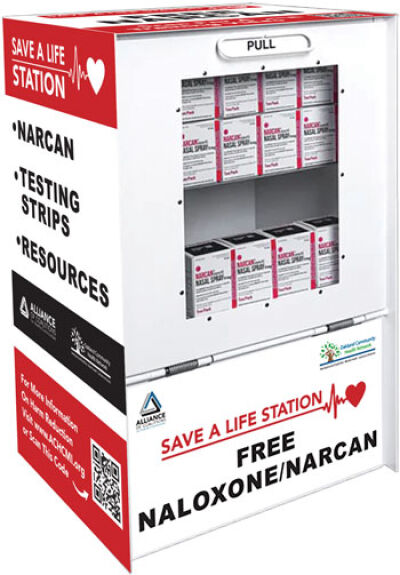
Save a Life stations can help save the lives of individuals who have overdosed on drugs. The stations were set to be dispersed at various locations in West Bloomfield and are free of charge.
Photo provided by Steve Norris
WEST BLOOMFIELD — West Bloomfield has seized on an opportunity that could potentially save the lives of some township residents.
As part of national opioid settlements, cities and townships were given the opportunity to apply for a share of settlement funds, with opioid treatment and prevention programs approved as uses for the funds.
“There were pharmaceutical companies who produced medication –—very powerful but addictive painkillers,” Township Supervisor Steven Kaplan said. “There were huge settlements between the pharmaceutical companies and states, and we received a letter in the mail (that) said if you would like to take part in the opioid settlement discussions, let us know. I had to complete various forms, send it in time to the government, and we received approximately $93,000 for the year 2022. We claimed residents have suffered harm as a result of the pharmaceutical company actions, and we easily qualified for funding.”
Kaplan expects the township to receive an additional $90,000 in funds this year.
With its funds, West Bloomfield has decided to make “Save a Life” stations available to residents.
The stations are a collaboration between West Bloomfield Township, the Greater West Bloomfield Community Coalition, the Oakland County Health Department, the West Bloomfield Fire Department, and the Michigan Department of Health and Human Services.
The stations have boxes with a lever that can be pulled to access naloxone, fentanyl testing strips and specially designed bags that destroy unused medication.
“This is a physical box,” said Steve Norris, the director of harm reduction and recovery support services for the Alliance of Coalitions for Healthy Communities. “It looks like the old-style newspaper box that you would pull down the door and access those resources individually, whenever you might need.”
West Bloomfield Fire Department Deputy Fire Marshal Dave DeBoer explained the goal of the Save a Life stations.
“The Narcan (a nasal device that delivers naloxone) is there to, hopefully, reverse an overdose before our paramedics can get on the scene and keep that person alive until they can say, ‘Hey, I’ve got a problem,’ and get into rehab,” he said. “We’re trying to save that life. … There’s also fentanyl test strips in there that people can use to test medication or whatever drug they’re taking to make sure it’s not laced with fentanyl. And then there’s also what’s called a Deterra bag.”
DeBoer elaborated on the use of Deterra bags.
“Those bags, you peel them open and dump old medicines in there that you no longer need that have opioids in them,” he said. “You pour a little bit of water in there and there’s activated charcoal and some other stuff in there that encapsulates the medications and makes it useless. Then you zip the thing closed, and you can throw it right in the garbage. It’s safe to dispose of in your trash.”
From DeBoers’ perspective, overdoses don’t always fit into the mold of the “1970s stereotypical drug addict.”
He said there can be a wide gamut of reasons for overdoses and that, “we’ve seen it from age 24 to 74.”
DeBoer pointed out that people may think that they are buying a particular kind of medication, but it can be laced with something else, such as fentanyl, which can cause an overdose.
“It can even be in something as simple as a marijuana joint that somebody laces with fentanyl or carfentanil, which is very powerful medication,” he said. “We see people that think they’re buying a pill — maybe they think they’re buying a form of like a speed.”
DeBoer also explained scenarios in which senior citizens have been known to overdose.
“(They) overdose because they took their medicine and they forgot they took their medicine and they take a second dose, or, more frequently now, we’re seeing a lot (of) pain patches,” he said. “Some of our senior citizens, they put a patch on (and) forget where they put it on. (They) put another one on, maybe even a third one, and now they’re overdosing because of their pain patches.”
To avoid accidental overdose, DeBoer recommends that residents get rid of any expired medications. He also suggests locking up edible marijuana, “just like any other medication.”
“Keep it secured and away from kids, because it looks like candy,” DeBoer said.
The Save a Life stations can be accessed by individuals who know of somebody who uses drugs and community members at large.
Naloxone “is something as a community member that we can all have on us to help save a life,” said Lisa Berkey, who is the executive director of the Greater West Bloomfield Community Coalition. “As an example, you might stop at 7-Eleven today, you may stop at Kroger; you could be anywhere where somebody might overdose in their car. You just never know where it may be, so to me, (naloxone) is for everybody.”
Norris shared a similar sentiment.
“The person that’s actually overdosing from an accidental exposure to fentanyl and/or opioids would not be able to administer themselves because at that point they would probably be in a state of unconsciousness,” he said. “However, this would be for a bystander who may be seeing this incident and … revive that person and restore breathing.”
On May 19, the first Save a Life station was placed at Fire Station No. 5, located on Maple Road, between Orchard Lake and Middlebelt roads.
Stations were set to be placed at the township’s other five fire stations, both library locations, at the parks and recreation building, and outside of the West Bloomfield Township Hall building, located at 4550 Walnut Lake Road.
Save a Life stations could also eventually be placed at some churches and synagogues.
Berkey shared her take on the benefits of the township being in a position to disperse the stations.
“They’re free resources, so anybody can get Narcan and be trained on it because there’s a QR code with a training video, and it’s free,” she said. “The same with the fentanyl strips and the Deterra bags — and it’s access, 24-7. As an example, the box is outside of the fire station, so the fire station doesn’t have to be open; (the) township doesn’t have to be open.”
Norris said that at each station throughout Oakland County there will be a minimum of 40 boxes of naloxone, 100 testing strips for fentanyl and 25 Deterra charcoal neutralizers.
He said that each of the stations also contains packets of resources for individuals who are seeking help.
Norris said that stations in Pontiac and Waterford also contain strips to test for xylazine, a sedative also known as “tranq.”
DeBoer credited Kaplan for having the “forethought” to apply for settlement funds, which allowed for the disbursement of the Save a Life stations.
“If we can save one life, which is incalculable, the program has succeeded,” Kaplan said.
Berkey recognizes the significance of giving residents access to tools that can save lives.
“Being able to have Narcan in anybody’s hands is remarkable,” she said. “Everybody can try to save a life and there’s no cost barrier. I know they made Narcan available over-the-counter, but it’s expensive, so it’s remarkable that us as a township are partnering with so many people to put this together for our residents.”
From Norris’ perspective, the stations are a way to offer potentially life-saving resources to residents with no barriers.
“They don’t have to interact with somebody,” he said. “They don’t have to go through any hoops. They don’t have to sign paperwork; they can literally get access to these resources free of charge when needed and not have to worry about the stigma. Most people, maybe, have a child or a loved one who’s suffering who may not be publicly out there letting them know, but they also want to make sure that those loved ones are safe. So this gives them access to those tools, so that with a little bit of training they can jump into action and be able to save their life and then have access to resources to offer their loved ones to get support so they can save their own life.”
 Publication select ▼
Publication select ▼
